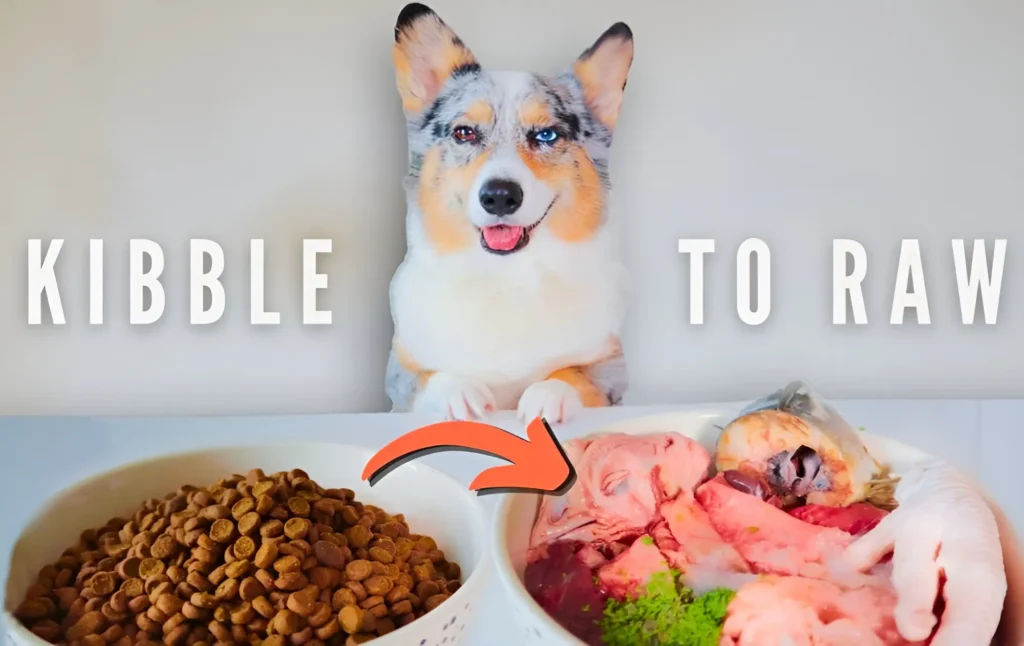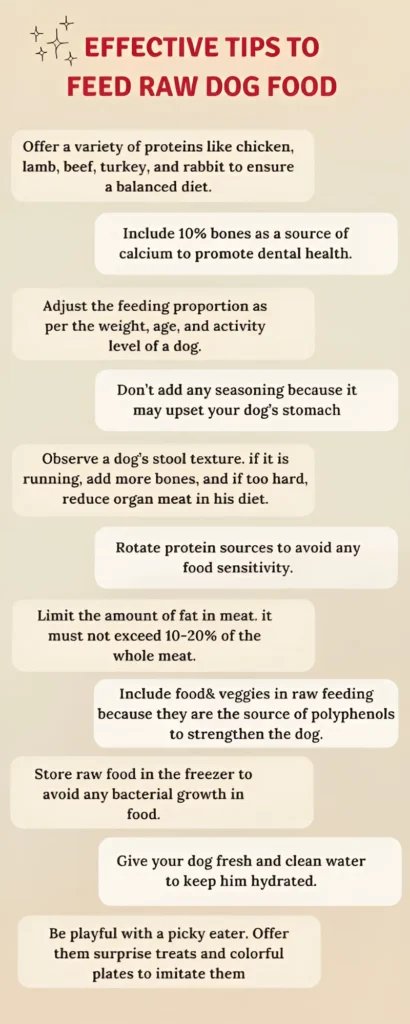
Do you resist raw food to your dog because you consider it imbalanced? Raw dog food means giving food raw to your dog without making it cooked. Feeding a portion of raw dog food to your beloved pup might be complex because of the fear of how much to feed, at what hours to feed, which thing to feed, and how to feed by transitioning from kibble to raw. Still, these perplexing points will be solved immediately in this article.
Transitioning to raw becomes easier if you have clear ideas about how to feed raw dog food, so let’s start finding out.
I break the article into 2 sections:
- How to feed raw dog food? Quick transition
- How much feeding quantity
How do you feed your dog while transitioning to raw food?
The dog owners who feed their dogs kibble food complain about their dog’s digestion problems because kibble is heavily processed with certain fillers, additives, and food colors. Moreover, the crunchy texture of kibble fails to clean the dog’s teeth, which develop tarter and plaque issues. Due to these downturns, dog owners turn to raw feeding, but they must learn how to feed raw food in transition periods. The concept is so simple.
Raw feeding to dogs may take 3-5 weeks. Plan to make your dog thoroughly familiar with raw food. But, my expert advice is to introduce only some of the meat protein at once to him. Introduce light proteins like chicken, turkey, or rabbit during the transition time, and if their body doesn’t show any reaction like diarrhea, add fresh food and supplements later in their raw feed.
When can you transition a dog or puppy to raw feeding? It could happen right after they wean from their mother’s milk, just as they can eat kibble.
Following up a proper check and balance on how this food transition is going for them is suggested. For this purpose, prepare documents about their age, breed, parent’s weight history, and vet concerns.
Here is the list of how to transition your dog from current food to raw.
There are two methods of transitions:
1- Cold turkey method
This method means to convert to raw food from the kibble with a jump, not by the steps. In this technique, without visiting your vet or with your friend and family’s assistance on Danone, you turn the food from highly processed (kibble) to raw. However, I don’t suggest this method, except that your dog is healthy with no stomach upset and has tried something raw as a treat before.
2- Gradual transition method
As the name tells you the truth, this method means transforming your dog’s food by giving him some time to understand the taste. This period may go from 2 weeks to a few months, but the best way is to do so without disturbing your dog’s whole system. It is subdivided into:
1- Raw as a treat
Transitioning your puppy to raw feeding could be easy if you use this technique to feed him the same food but to build up the habit of consuming raw; give him treats like a chicken piece, chicken heart, chicken neck, ribs, or wing. This way, build up your dog’s positive association with the raw food.
2- Feed kibble and raw in one meal.
It is the perfect example of gradual transitioning. I implemented it on my dogs when they wean their mother feed. In this method, make two proportions of food: kibble and one raw, but day by day or week by week, decrease the feed of kibble and increase the amount of raw food to your dog. How it works, let’s see this six-week challenge.
Weeks transition | Kibble food | Raw food |
One | 7/8 | 1/8 |
Two | 3/4 | 1/4 |
Three | 1/2 | 1/2 |
Four | 1/4 | 3/4 |
Five | 1/8 | 7/8 |
Six | No kibble | 100% raw |
3- Feed kibble and raw in separate mealtimes.
This transition is also a promising start-up for all stages of dogs. Despite that, this approach is similar to the previous one, but in this transition plan, your dog will get kibble at one time and raw for the second time, but keep the proportion chart mentioned above in mind, too.
My insightful suggestion to all feeders while they convert their dogs to raw is to feed raw in the morning and kibble at night because when they remain active throughout the day, the new food (basic) will be more accessible to digest and familiar to their tummies.
4- Raw transition feeding to picky dogs
Start working not too immediately; do it within weeks from your dog’s current food to raw. If your dog is too picky and has a common immune weakness, this method is for you. For the first few days, cook the food 3/4, then 1/2, 1st, then 1/4, and mix that cooked meat with kibble to accustom them to the raw, then gradually switch the bowl of raw with the kibble. The 5-week start-up menu looks like this:
Weeks | Protein | Organs | Bones |
1 | Chicken | Chicken liver, spleen | Chicken necks |
2 | Chicken | Beef tripe | Chicken ribs |
3 | Turkey | Duck gizzard | Lamb's neck |
4 | Duck or rabbit | Chicken heart | Duck wings |
5 | Beef, venison, bison, or fish | Pork liver | Venison ribs |
- Always check for any sensitivity and upset stomach.
- Before moving to raw, consult with your vet.
- Introduce chicken as a first protein, then gradually add more proteins.
- Balance the content of meat, organs, and bone because too much bone makes a dog’s stool harder, while more organs and meat results in vomiting and diarrhoea.
- Grind the bones, meat, and organs for the first few weeks to avoid choking hazards, or buy raw ground bones and meat.
How much feeding quantity?
As you switch from kibble to raw dog food, a dog owner may want to know the answer to this mostly asked question: How much should I feed my dog? So, we provide a clear explanation that feeding quantity depends on age, activity level, and breed of a dog, but here is a correct estimation you should bear in mind.
Prey model ratio for adult dogs:
- 80% muscle meat
- 10% raw meaty bones (Duck neck & Chicken drumsticks)
- 5% liver
- 5% other secreting organs
For puppies:
- 69-71% muscle meat
- 15-17% raw meaty bones (Rabbit & Chicken)
- 7% liver
- 7% of other secreting organs
* Secreting organs: spleen, pancreas, thymus, brain, eyeballs, kidney, testicles, and ovaries.
*supplementary diet: Canned oyster, wheat grass powder, pumpkin seeds, Kelp (for iodine), green tripe (for manganese), vitamin E, oily fish ( for EPA/ DHA), and green vegetables.
How many times a day should you feed your dog? Split the food between 3-4 times during the first six months and then go by to provide them 2-3 times after they reach their adult age, along with a surprise treat.
Dog’s activity level | % of a body weight |
Average dog | 2-3% |
Highly active dog | 3% |
Inactive dog | 2% |
Sporting dog | 3.5% |
Obese dog | 1.5% |
How do you feed raw dog food? General tips
Feeding raw food to dogs depends on the owner’s management; either he feeds the full daily feed at one time or half the quantity in the morning and half in the evening. Some of the valuable tips for providing raw dog food are:

More tips include:
* Monitor the PH level of your dog’s urine. Usually, it is yellow to amber in color. Dogs urinate 3-5 times a day ( urine frequency depends on the amount of raw food intake, water intake, breed, age, and dog weight). Still, if your dog shows any difficulty urinating or is smelly and bloody, it could be the harmful impact of raw dog food on their stomach.
*Choose high-quality feeding ingredients that must be top quality, human-grade, and must be from reputable sources.
* Every time, wash your hands and prepare a place to avoid contracting bacterial infections in your dog.
* If you find preparing raw feed at home problematic, commercial raw dog food companies are always at your gateway.
User guide corner
Is raw food suitable for all dogs?
No, a raw dog food diet is not appropriate for all dogs. If your dog is pregnant, has a specific disease (kidney & stomach), or has some breed abnormality (flat-faced dog), you must consult your vet before feeding him a raw diet.
How do I give my dog a diet that contains all the essential nutrients?
The dog is a natural prey animal that loves everything that is meat. So, for balanced nutrients, add muscle meat, bones, organ meat, fruits & veggies, nuts, herbs, and supplements to the dog’s daily feed.
How can I monitor my dog’s health when he is on raw feeding?
Monitor your dog’s weight, body condition, stool quality, energy levels, and overall well-being. Any significant changes should be discussed early with your veterinarian.
What is the most suitable way to feed raw food to dogs?
During the first week, if the dog is healthy, or for the first 3 days, feed raw and current food with the proportion of 15% and 85%, respectively. Then, gradually increase the percentage of raw food to 25%, then 50%, then 75%, and at last, 100%.
Ended up
In conclusion, the best way to feed your dog raw food should be decided after considering your lifestyle, your dog’s specific dietary needs, and your capacity to give them a balanced diet. Throughout the transition, it’s critical to undertake extensive research, communicate with veterinary professionals, and keep close tabs on your dog’s well-being and overall health.
